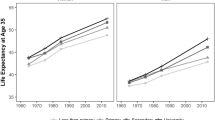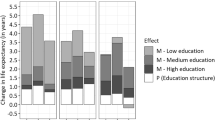Abstract
Several recent articles have reported conflicting conclusions about educational differences in life expectancy, and this is partly due to the use of unreliable data subject to a numerator-denominator bias previously reported as ranging from 20 % to 40 %. This article presents estimates of life expectancy and lifespan variation by education in the United States using more reliable data from the National Health Interview Survey. Contrary to prior conclusions in the literature, I find that life expectancy increased or stagnated since 1990 among all education-race-sex groups except for non-Hispanic white women with less than a high school education; there has been a robust increase in life expectancy among white high school graduates and a smaller increase among black female high school graduates; lifespan variation did not increase appreciably among high school graduates; and lifespan variation plays a very limited role in explaining educational gradients in mortality. I also discuss the key role that educational expansion may play in driving future changes in mortality gradients. Because of shifting education distributions, within an education-specific synthetic cohort, older age groups are less negatively selected than younger age groups. We could thus expect a greater concentration of mortality at younger ages among people with a high school education or less, which would be reflected in increasing lifespan variability for this group. Future studies of educational gradients in mortality should use more reliable data and should be mindful of the effects of shifting education distributions.




Similar content being viewed by others

Notes
These results should be interpreted with caution given that overall lifespan variability increased by a slight amount for non-Hispanic whites in U.S. life tables but decreased slightly in NHIS data.
However, the reported increase in mortality among middle-aged white men in Case and Deaton (2015) may be overstated because of failure to age-standardize.
References
Bound, J., Geronimus, A. T., Rodriguez, J. M., & Waidmann, T. A. (2015). Measuring recent apparent declines in longevity: The role of increasing educational attainment. Health Affairs, 34, 2167–2173.
Case, A., & Deaton, A. (2015). Rising morbidity and mortality in midlife among white non-Hispanic Americans in the 21st century. Proceedings of the National Academy of Sciences, 112, 15078–15083.
Dowd, J. B., & Hamoudi, A. (2014). Is life expectancy really falling for groups of low socio-economic status? Lagged selection bias and artefactual trends in mortality. International Journal of Epidemiology, 43, 983–988.
Elo, I. T. (2009). Social class differentials in health and mortality: Patterns and explanations in comparative perspective. Annual Review of Sociology, 35, 553–572.
Hendi, A. S. (2015). Trends in U.S. life expectancy gradients: The role of changing educational composition. International Journal of Epidemiology, 44, 946–955.
Ho, J. Y. (2013). Mortality under age 50 accounts for much of the fact that US life expectancy lags that of other high-income countries. Health Affairs, 32, 459–467.
Ho, J. Y. (2017). The contribution of drug overdose to educational gradients in life expectancy in the United States, 1992–2011. Demography. Advance online publication. doi:10.1007/s13524-017-0565-3
Keyfitz, N. (1966). A life table that agrees with the data. Journal of the American Statistical Association, 61, 305–312.
MPC (2015). Integrated Health Interview Series: Version 6.12 [Minnesota Population Center and State Health Access Data]. Minneapolis: University of Minnesota. Retrieved from http://www.ihis.us
Olshansky, S. J., Antonucci, T., Berkman, L., Binstock, R. H., Boersch-Supan, A., Cacioppo, J. T., . . . Rowe, J. (2012). Differences in life expectancy due to race and educational differences are widening, and many may not catch up. Health Affairs, 31, 1803–1813.
Rostron, B. L., Boies, J. L., & Arias, E. (2010). Education reporting and classification on death certificates in the United States (Vital and Health Statistics, Series 2 No.151). Washington, DC: National Center for Health Statistics.
Sasson, I. (2016). Trends in life expectancy and lifespan variation by educational attainment: United States 1990–2010. Demography, 53, 269–293.
Sorlie, P. D., & Johnson, N. J. (1996). Validity of education information on the death certificate. Epidemiology, 7, 437–439.
Xu, J., Murphy, S. L., Kochanek, K. D., & Arias, E. (2016). Mortality in the United States, 2015 (NCHS Data Brief No. 267). Hyattsville, MD: National Center for Health Statistics.
Acknowledgments
The author is supported by grants from the National Institute on Aging (T32 AG000177 and AG000139) and the National Institute of Child Health and Human Development (T32 HD007242). Jessica Ho, Scott Lynch, and three anonymous reviewers provided helpful comments and suggestions.
Author information
Authors and Affiliations
Corresponding author
Appendix
Appendix
Rights and permissions
About this article
Cite this article
Hendi, A.S. Trends in Education-Specific Life Expectancy, Data Quality, and Shifting Education Distributions: A Note on Recent Research. Demography 54, 1203–1213 (2017). https://doi.org/10.1007/s13524-017-0574-2
Published:
Issue Date:
DOI: https://doi.org/10.1007/s13524-017-0574-2



